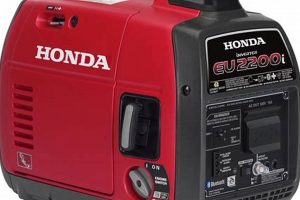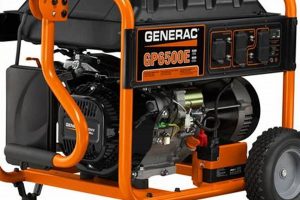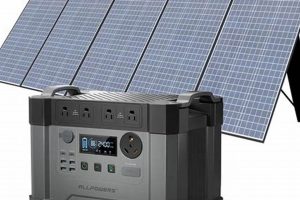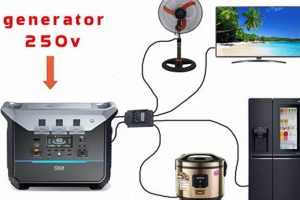High-quality mobile power sources designed for residential use offer a crucial safety net against power outages. These units can power essential appliances, from refrigerators and lights to sump pumps and medical devices, ensuring comfort and safety during disruptions. A prime example is an inverter generator capable of delivering consistent, clean power suitable for sensitive electronics.
Reliable backup power is increasingly vital in today’s world, protecting homeowners from the disruptions of severe weather, grid instability, and other unforeseen events. Historically, portable generators have evolved from noisy, less efficient machines to quieter, more technologically advanced models featuring fuel efficiency and inverter technology for cleaner power delivery. This evolution underscores the growing importance of reliable backup power for homeowners.
Further exploration will delve into specific features to consider when selecting a suitable unit, popular models available on the market, and essential safety precautions for operation and maintenance.
Tips for Selecting and Using Portable Generators
Choosing and operating a portable generator requires careful consideration to ensure safety and effectiveness. The following tips offer guidance for homeowners seeking reliable backup power.
Tip 1: Calculate Power Needs: Determine the wattage required to run essential appliances. Add up the starting and running wattage of devices intended for simultaneous use. Overloading a generator can cause damage.
Tip 2: Choose the Right Fuel Type: Gasoline, propane, and dual-fuel models offer varying benefits regarding fuel availability, storage, and runtime. Consider typical outage durations and fuel storage capabilities.
Tip 3: Prioritize Inverter Technology: Inverter generators produce cleaner power, suitable for sensitive electronics like computers and televisions. They also offer improved fuel efficiency and quieter operation.
Tip 4: Consider Portability and Size: Evaluate the generator’s weight and dimensions, especially if frequent movement is anticipated. Wheel kits and handles can enhance portability.
Tip 5: Ensure Proper Installation: A qualified electrician should install a transfer switch to safely connect the generator to the home’s electrical system. This prevents backfeeding into the power grid, a serious safety hazard.
Tip 6: Adhere to Safety Guidelines: Operate the generator outdoors in a well-ventilated area, away from windows and doors. Never refuel a hot generator.
Tip 7: Implement Regular Maintenance: Follow the manufacturer’s recommendations for oil changes, air filter cleaning, and other maintenance tasks to ensure optimal performance and longevity.
By considering these tips, homeowners can make informed decisions, ensuring safe and effective backup power during outages. Proper selection, installation, and maintenance are vital for maximizing a portable generator’s benefits.
These considerations pave the way for informed purchasing decisions and safe operation, ultimately providing peace of mind during power disruptions.
1. Power Output
Power output, measured in watts, is a critical factor when selecting a portable generator. It directly determines which appliances can be powered simultaneously and effectively. Understanding power output nuances is essential for informed decision-making.
- Starting vs. Running Watts
Appliances require a surge of power upon startup (starting watts), which significantly exceeds the power needed for continuous operation (running watts). Generators must accommodate both. For example, a refrigerator might require 2,000 starting watts but only 700 running watts. Top-tier portable generators clearly specify both values, enabling informed appliance selection.
- Total Power Needs Calculation
Accurately assessing total power requirements is crucial. Calculate the combined running watts of all intended appliances and factor in the highest starting wattage among them. This ensures the generator can handle the initial surge and sustained operation. Overestimating needs provides a safety margin but necessitates a potentially larger, more expensive generator.
- Generator Size and Power Output Correlation
Generator size generally correlates with power output. Larger generators offer higher wattage but come with increased cost, size, and fuel consumption. Smaller generators are more portable and economical but may limit the number of simultaneously powered devices. Balancing power needs with portability and cost is central to selecting a top portable generator.
- Power Output and Inverter Technology
Inverter generators, known for clean power delivery suitable for sensitive electronics, also offer varying power outputs. While generally smaller and more portable, higher-wattage inverter models provide sufficient power for multiple devices. This technology caters to both power needs and the demand for stable, clean electricity, a hallmark of leading portable generators.
Careful consideration of these power output facets allows consumers to match generator capacity to specific needs. Understanding the interplay between starting watts, running watts, total power requirements, and generator size is crucial for selecting a top-performing portable generator capable of reliably powering essential devices during outages.
2. Fuel Efficiency
Fuel efficiency plays a crucial role in the overall value and practicality of top portable home generators. Efficient fuel consumption translates to longer runtimes, reduced operating costs, and less frequent refueling, especially critical during extended power outages. Understanding the factors influencing fuel efficiency helps consumers make informed decisions.
- Runtime and Fuel Consumption
Runtime, indicating how long a generator operates on a full tank of fuel, is directly linked to fuel consumption. Top-performing portable generators often feature larger fuel tanks and efficient engines to maximize runtime. Manufacturers typically provide runtime estimates at various load levels (e.g., 25%, 50%, 100% load), enabling users to anticipate operational durations under different power demands. Longer runtimes minimize refueling disruptions, a key advantage during prolonged outages.
- Engine Technology and Efficiency
Engine design and technology significantly impact fuel efficiency. Modern OHV (Overhead Valve) engines, commonly found in high-quality portable generators, offer improved combustion and fuel economy compared to older engine designs. Inverter generators further enhance efficiency by adjusting engine speed based on power demand, minimizing fuel consumption during lighter loads. These advancements contribute to the overall cost-effectiveness and operational efficiency of top-rated generators.
- Load Management and Fuel Economy
Operating a generator at its maximum capacity consumes fuel more rapidly. Strategic load management, prioritizing essential appliances and avoiding unnecessary power usage, helps optimize fuel efficiency and extend runtime. Powering only essential devices contributes to fuel conservation and cost savings, vital aspects of generator operation, especially during extended power outages.
- Fuel Type and Efficiency Comparisons
Different fuel types exhibit varying energy densities and combustion characteristics, impacting efficiency. Propane, for example, generally burns cleaner than gasoline but might offer slightly lower energy density. Dual-fuel generators, capable of utilizing both gasoline and propane, provide flexibility based on fuel availability and cost. Understanding these fuel-specific characteristics helps consumers choose the most suitable option based on individual needs and circumstances.
Fuel efficiency is a key consideration in evaluating portable generators. Analyzing runtime estimations, understanding engine technologies, implementing effective load management strategies, and considering fuel type variations empowers consumers to select top-tier generators offering optimal fuel economy and extended operation during critical power outages. This emphasis on efficiency contributes to the overall value and practicality of these essential backup power solutions.
3. Noise Levels
Noise levels are a significant consideration when evaluating portable generators, particularly for residential use. Excessive noise can disrupt daily life, irritate neighbors, and even violate local noise ordinances. Top-tier portable generators prioritize noise reduction through advanced engineering and design. This focus on quiet operation distinguishes high-quality models from less refined alternatives.
Several factors influence generator noise levels. Engine design and construction play a key role. Modern OHV engines, often featuring enclosed designs and advanced muffling systems, contribute to quieter operation. Inverter generators, known for their variable engine speed, further reduce noise output, especially during periods of low power demand. Operating the generator on a level surface also minimizes vibrations and associated noise.
Manufacturers typically specify noise levels in decibels (dB). A lower dB rating indicates quieter operation. For context, a typical conversation registers around 60 dB, while a lawnmower operates around 90 dB. Top-rated portable generators often achieve noise levels between 50-60 dB at a conversational distance, minimizing disturbance. This consideration is crucial for maintaining peaceful environments during power outages. Selecting quieter models enhances user comfort and fosters positive neighborly relations.
4. Portability
Portability is a defining characteristic of top portable home generators, directly influencing their practicality and usability. The portability of these units stems from a combination of factors, including size, weight, and integrated features like wheels and handles. Compact designs and lightweight construction, often achieved through the use of advanced materials, enable easier transport and maneuverability. Integrated wheels and ergonomic handles further enhance portability, allowing users to move the generator across various terrains, from paved surfaces to uneven ground. This ease of movement is essential for positioning the generator safely outdoors, away from windows and doors, as recommended for safe operation.
The practical significance of portability becomes readily apparent in various scenarios. Consider a homeowner needing to power a sump pump in the basement during a power outage. A portable generator’s maneuverability allows quick deployment to the necessary location. Similarly, for outdoor events or camping trips, a portable generator can provide power for lighting, cooking appliances, and other necessities. The ability to readily transport the generator expands its utility beyond emergency home backup power, making it a versatile power source for various applications. For example, contractors might utilize portable generators on job sites lacking grid access, showcasing the practical implications of portability in professional settings.
In conclusion, portability is not merely a convenient feature but a defining attribute of top portable home generators. It directly impacts the ease of use, transport, and deployment in diverse situations, expanding the generator’s utility beyond the confines of the home. The combination of compact design, lightweight construction, and integrated mobility features contributes to the overall practicality and value of these essential power solutions. This careful consideration of portability distinguishes leading generator models, catering to the diverse needs of users in various contexts, from emergency home backup power to recreational activities and professional applications.
5. Safety Features
Safety features are paramount in top portable home generators, differentiating high-quality models from less reputable options. These features protect users, connected appliances, and the broader electrical grid from potential hazards associated with generator operation. Prioritizing safety is non-negotiable when selecting a reliable backup power source.
- Automatic Shutoff for Low Oil Levels
Low oil levels can cause severe engine damage. Top-tier generators incorporate sensors that automatically shut down the engine when oil levels drop below a critical threshold. This prevents costly repairs and ensures safe operation, a critical feature often overlooked in lower-quality models. For example, imagine a homeowner starting a generator during a nighttime outage, unaware of low oil. This feature prevents potential engine failure, maintaining power supply during crucial times.
- Carbon Monoxide (CO) Detection and Shutoff
Carbon monoxide (CO) poisoning is a serious risk associated with generator operation. High-quality generators include CO sensors that detect elevated levels of this odorless, colorless gas. Upon detection, these sensors automatically shut down the generator, preventing potential exposure. This life-saving feature is essential for safe indoor and outdoor operation, mitigating a significant health hazard. In a scenario where a generator is inadvertently placed too close to an open window, this feature protects inhabitants from potential CO poisoning.
- Overload Protection
Connecting too many appliances or exceeding the generator’s rated wattage can cause overloading, potentially damaging both the generator and connected devices. Top portable generators incorporate overload protection mechanisms, such as circuit breakers, which automatically trip in overload situations. This prevents damage and ensures the generator operates within safe limits. For instance, if a homeowner attempts to run a power-hungry appliance beyond the generator’s capacity, the overload protection will activate, safeguarding the system from damage.
- Covered Outlets and Ground Fault Circuit Interrupter (GFCI) Protection
Exposure to rain or moisture can create electrical hazards. Leading portable generators feature covered outlets to protect against the elements. Additionally, GFCI protection, similar to that found in bathroom outlets, further enhances electrical safety by detecting ground faults and immediately interrupting the circuit. This prevents shocks and electrocution, especially in damp conditions. Imagine using a generator outdoors during light rain. Covered outlets and GFCI protection safeguard against electrical hazards, ensuring user safety.
These safety features are integral to the design and functionality of top portable home generators. They underscore a commitment to user safety and responsible operation. Consumers should prioritize these features when evaluating generator options, ensuring reliable and safe backup power during outages. Investing in a generator equipped with these safety mechanisms provides peace of mind and mitigates potential risks associated with power generation.
Frequently Asked Questions
This section addresses common inquiries regarding portable generators for residential use. Clear and accurate information is crucial for informed decision-making and safe operation.
Question 1: How is the necessary generator size determined?
Generator size is determined by calculating the total wattage required to power essential appliances. Sum the running watts of all intended devices and factor in the highest starting wattage among them. Consulting an electrician can provide further guidance.
Question 2: What differentiates conventional generators from inverter generators?
Inverter generators produce cleaner, more stable power suitable for sensitive electronics. They also offer quieter operation and better fuel efficiency compared to conventional generators.
Question 3: Is professional installation required?
While basic setup can be handled by homeowners, connecting a generator to a home’s electrical system requires a transfer switch, professionally installed by a qualified electrician. This prevents backfeeding into the power grid, a significant safety hazard.
Question 4: What safety precautions are essential during operation?
Generators should always be operated outdoors in well-ventilated areas, away from windows and doors, to prevent carbon monoxide poisoning. Refueling should never occur while the generator is running or hot.
Question 5: What maintenance is required for optimal performance?
Regular maintenance, including oil changes, air filter cleaning, and spark plug replacement, is essential for optimal generator performance and longevity. Consult the manufacturer’s recommendations for specific maintenance schedules.
Question 6: How does fuel type influence generator selection?
Gasoline, propane, and dual-fuel generators offer distinct advantages. Gasoline offers wide availability, while propane allows for longer-term storage. Dual-fuel models provide flexibility. Consider typical outage durations and fuel storage capabilities when selecting a fuel type.
Careful consideration of these frequently asked questions empowers consumers to make informed decisions regarding portable generator selection, installation, and safe operation. Addressing these common concerns ensures reliable backup power during outages.
For further information, one might consult resources such as consumer reports, manufacturer specifications, and expert reviews.
Conclusion
Careful evaluation of critical factorspower output, fuel efficiency, noise levels, portability, and safety featuresis essential when selecting high-quality portable generators for residential use. Understanding these aspects ensures consumers acquire units capable of meeting specific power needs reliably and safely during outages. Prioritizing these considerations contributes to informed decision-making and ultimately provides peace of mind during unforeseen power disruptions.
Investing in a robust and reliable portable generator represents a significant step towards enhancing household resilience. Thorough research and careful selection empower homeowners to mitigate the impact of power outages, ensuring the safety and well-being of families and safeguarding essential appliances. This proactive approach to emergency preparedness underscores the value of reliable backup power in today’s world.






